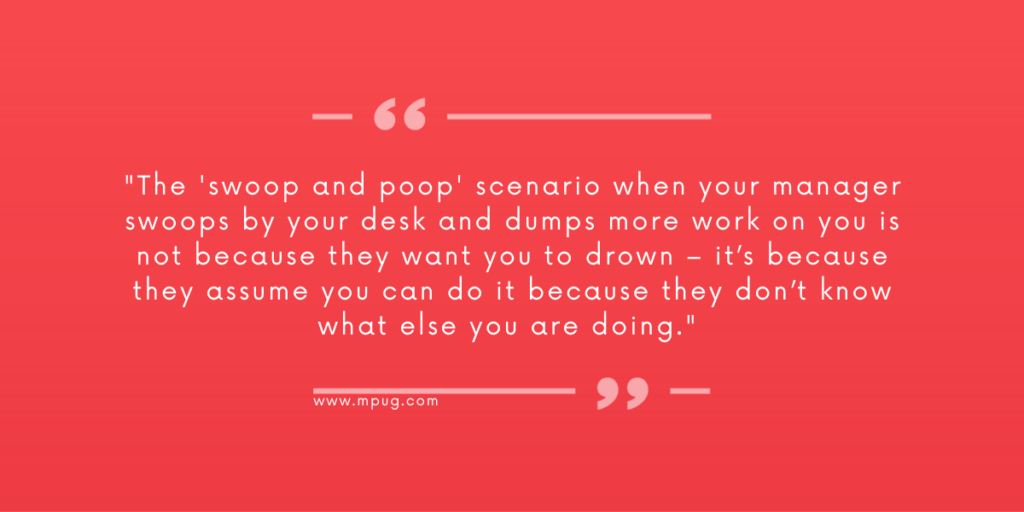
Feeling overwhelmed? You’re not alone. Nearly 30% of project managers say that workload has been their biggest cause of stress over the past year and it’s a major factor for why people consider leaving their jobs.
You might feel like you’re in a situation you can’t control, but something you can influence is how much your manager understands about the work you’ve got on. In my experience, bosses don’t always know how many projects we are juggling and what else is making demands on our time. The ‘swoop and poop’ scenario when your manager swoops by your desk and dumps more work on you is not because they want you to drown – it’s because they assume you can do it because they don’t know what else you are doing.
Let me remind you: you can’t do it all. And your boss knows that too.
But you have to help them help you, and that starts with having an open conversation about your workload. Here’s what to do in seven clear steps (and it’s not scary, promise!).
1. Block your calendar
Ring-fence some time for yourself to do the thinking and planning for the conversation with your manager.
Book as much time out in your calendar as you can for the next 48 (working) hours. Book meetings with yourself and turn your status to ‘unavailable’. You’re not off-the-grid, so keep any important meetings. This is simply to give you a breather so you can get your facts and thoughts together before you speak to your manager.
2. Book a meeting with your manager
Book the meeting for a couple of days’ time, after you’ve finished gathering your notes and reflecting on your current workload. Bosses are busy people, so get it in the diary now. Booking the time also means you’re both committed and you won’t back away from having the conversation, however worrying it might seem right now!
3. Make a list of all your current work
Combine all your To Do lists and worries, sticky notes, and jottings. Make one big list of all the things you are currently expected to do.
There’s lots of information on how to do this in my book, Managing Multiple Projects, but the key is to include both project work and non-project work. All the team management, leadership meetings, recruitment, social event organizing, mentoring, template design – everything that isn’t part of one of your projects also goes on the list.
The list will probably be too long for you to comfortably manage, which is why you feel like your workload is too much, right? Think about which items could be handed off to someone else, done slower, or not done at all.
4. Circle anything that isn’t in your job description
As our roles expand, so too does the burden. You’ve heard the saying: If you want something done, give it to a busy person – there’s a reason why that’s true!
Mark anything on your work list that is not formally part of your job responsibilities. These are the tasks that you’ve picked up along the way. For example, maybe you’re now managing a supplier relationship, or have taken on a product owner role for one of your department’s tools. Maybe you’re the superuser for your PPM tool and you do all the training for new starters.
If there are a lot of non-job description tasks, plan to talk to your boss about your expanding role and what needs to give, so you can focus on your new responsibilities (assuming you want to keep them).
5. Circle anything that is increasing your stress levels
Pick out the tasks that are increasing your levels of anxiety. What are the things that are causing the most stress? Circle the top couple of things, e.g.:
- Something you are worried about asking for or doing
- A big task that is overwhelming (so it needs to be broken down into smaller, doable chunks)
- Something that puts you out of your comfort zone
Identifying the stressors is a way of feeling more in control of them, and you can also focus your energies on getting those done.

6. Tick off some smaller tasks
You’ve gathered your data now. You know what you are doing and you know what you’ve taken on by stealth, above and beyond your day job role. You’ve highlighted the top issues that are keeping you up at night.
Use the rest of your blocked-out time to bust through as many outstanding tasks as possible. Clear out your inbox, reply to your Teams messages, submit the draft of that report that’s been sitting with you for a week.
Look at what’s on your To Do list and ask yourself: will this matter in 3 days? If the answer is no, just find a solution that can be done quickly and do it.
Try to clear the decks, but be sure to timebox this activity, as the small tasks are often the ones that are the least likely to get us closer to big goals like completing a project. The point of doing this for a couple of hours is to make yourself feel like the small things aren’t contributing to the feeling of drowning.
7. Meet your manager
It’s time to meet! The only thing you have to do is show up, share your findings, and be honest.
Take your notes with you so you have the evidence to look at together. Have a conversation along these lines:
“I feel like I’ve got a lot of work on the go at the moment, and partly it’s due to how my role has grown over the last 12 months. I’d like us to look over my priorities together and work out the best way to tackle everything so I can make sure I’m concentrating on the most important aspects of the job.”
You want to sound confident and proactive, open to suggestions and help, but also be prepared to push back based on the data you have about your current workload.
Say something like: “I’ve got five projects at the moment, and they each need more than a day a week. I don’t have the capacity to do them all and hit the deadlines set by the Board. If we can’t shift the dates, it might be necessary for me to hand one of these off to someone else so we can get them all done in time as a team.”
Offer some suggestions, for example, training up a colleague in a task you do regularly, automating a workflow to avoid manual work, or removing yourself from regular meetings that you no longer need to attend.
The goal is to end the meeting having had a frank conversation about what you are currently working on, what your priorities are and what they should be, what’s increasing your stress levels, and what tasks can be removed, postponed, or delegated.
A good manager will be concerned about your workload and will help you identify which items should take your focus and which can wait. They will need to take into account the workload of the rest of the team, but they should help you set clear priorities and they’ll leave the conversation knowing exactly what work you have on.
The Bottom Line – Don’t Wait! Deal with overwhelm.
The thing with workload issues is that they tend to only get worse… so if you’ve gotten this far and you think you do need to have a conversation with your boss, act now and deal with the overwhelm. You’ll feel so much better for it!
Related Content
8 Tips for Better Time Management: Project Manager Edition








Daryl Deffler
I had a Swoop and Poop manager years back who constantly dropped “critical” new work on me/my team and then later would rant/yell because the original work was not getting done. He did this across the organization.
I resolved the issue by requiring the manager to set my priorities, 1-5. No ties and not everything is top priority. I then asked him to define the amount of focus each item got, totaling no more than 100%. For example, #1, got 40%, #2 got 25%, and so on. We agreed to this approach. (him reluctantly).
I documented these priorities on my office board. Then, every time he swooped in with new work requests, I simply pointed at the agreed upon priority list and asked which this takes precedence over, and what items on the list should be stopped. It was always his decision and if he changed it, I had no problems with it. But effectively, I put the decision on him so that he was, in essence, arguing with his owned defined priority list. After a while, he stopped swooping, the yelling stopped, and my team actually managed to get the priority work done as needed.
Elizabeth Harrin
That sounds like a success, Daryl, thanks for sharing your approach. Even if people don’t have an office board in a virtual environment, they can certainly create a prioritised list that they bring up when taking on another project/task is discussed.